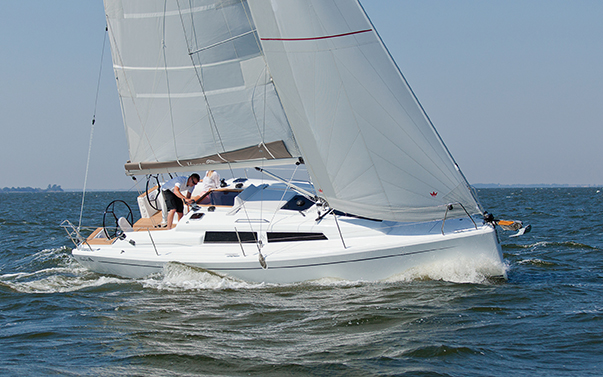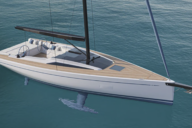Previously published in BWS by Zuzana Prochazka.
Hanse Yachts builds big impressive boats. The German manufacturer’s 67-foot flagship recently splashed in Europe and it is a muscle-bound speedster. But sometimes, it takes extra know-how to build small rather than big and the Germans have gotten it right at both ends with the introduction of the smallest sister in the fleet, the Hanse 315.
Like her siblings, the 315 is the product of the team, Judel/Vrojilk, the latter being the design force behind America’s Cup contender, Alinghi. With that pedigree and her vacuum-bagged, cored epoxy sandwich construction, this new pocket cruiser is a contender.
The Hanse 315 replaces the older 325 and with her self-tacking 98 percent jib on a curved track ahead of the mast, she’s a joy to sail, even singlehanded. There is an option to add jib tracks on the side decks and a 105 percent overlapping jib but that will not increase the sail area by much and would take away from how easy she is to manage, so why opt for the extra cost? The deck-stepped Selden mast is tapered, has double aft-swept spreaders and carries Elvstrøm laminate sails. Below the waterline, you have a choice of two keel drafts: six foot one inches or four foot five inches with the deeper draft providing better upwind performance and the latter enabling you to sail the skinny waters off much of the East Coast.
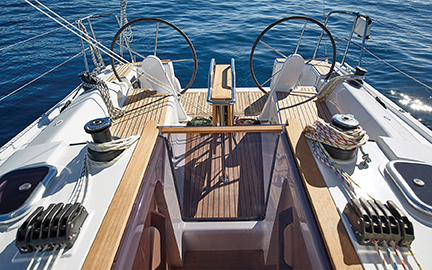 Twin carbon wheels, by the Danish company Jefa, open up the cockpit and provide good sightlines forward as well as a smooth flow from the companionway to the drop down transom (manual) which creates a nice swim platform. The twin backstays also help in keeping the stern clear of obstacles and are placed well so a tall helmsman can still stand at the wheel without hitting his head on the wires.
Twin carbon wheels, by the Danish company Jefa, open up the cockpit and provide good sightlines forward as well as a smooth flow from the companionway to the drop down transom (manual) which creates a nice swim platform. The twin backstays also help in keeping the stern clear of obstacles and are placed well so a tall helmsman can still stand at the wheel without hitting his head on the wires.
A B&G chartplotter and instruments are at the port wheel and twin Lewmar primary winches are easy to reach from either wheel. The rest of the lines are controlled by two winches and Spinlock rope clutches on the cabintop. U.S. boaters will want to add the optional side boarding gates (since we don’t tend to Med moor in North America) and possibly teak slatting in the cockpit to break up the expanse of white fiberglass. Cup holders would be nice since there aren’t any.
PERFORMANCE
Our five-ton test boat was equipped with a fuel-efficient 18 horsepower Volvo that powered the hull at 6.9 knots at 3,000 rpm. The standard engine is 12 horsepower but an upgrade will make all the difference when heading for home, upwind in deteriorating conditions.
We powered out onto the Chesapeake Bay where we were met with disappointingly light winds at first. But when puffs of eight to 12 knots apparent wind came through, the Hanse 315 picked up to 5.8 knots at 45 degrees and six knots at 60 degrees. Busy tidying lines and talking, we barely noticed that the boat was completely taking care of herself, tracking well and even missing crab pots that materialized in our path.
We tacked through 80 degrees and fell off onto a broad reach, keeping the speed of 5.3 knots at 120 degrees apparent wind angle. The large mainsail blocks the small jib when on a run so we changed to wing-on-wing where both sails had the chance to draw and keep our speed up.
We noticed how light and responsive the helm was at all angles of sail. One finger on either of the two wheels kept everything under control to the point where we started to take note of the lovely afternoon, getting lost in enjoying the time aboard. The boat practically sailed herself which bodes well for singlehanders or distracted sailors keeping an eye on young kids. The self-tacking jib means there will not be any scrambling about in the cockpit when changing direction and the ease of sailing will likely translate to more frequent use, even for short afternoon jaunts about the harbor. And isn’t that what it’s all about?
Make no mistake however, the Hanse 315 is completely capable of extended coastal cruising and weekending with all necessary amenities including 60 gallons of fresh water and 26 gallons of fuel. It’s good to know that 31 feet will work just as well as 67 when it’s time to get away from the dock. The new model will suit new sailors just getting into the sport or seasoned salts looking to downsize and get out on the water more often with less hassle—and expense.
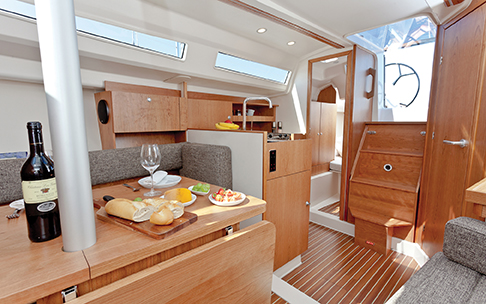
COMFORTABLE INTERIOR
The Hanse 315 won’t accommodate a crowd, but four will be comfortable in the two-cabin, single head layout. A large overhead opening hatch and a fixed port in the deck flood the saloon with light where a centerline table separates two straight settees. A small nav desk shares a seat with the portside bench so the ship’s business can have a dedicated space. The L-shaped galley to starboard has a single circular sink near the centerline, Waeco top-loading refrigeration and a two-burner Eno stove/oven combination along with plentiful black quartz countertops. All in all, this galley will work well for a chef on a weekend cruise.
As has become popular on other models, the bulkhead that separates the forward cabin from the saloon may be removed, leaving the whole boat feeling much larger and more open. With the bulkhead in place, the stateroom is private with a small luggage table to starboard. This cabin will work well for kids since the bed can also be split into two berths with shelves that fold out. The master stateroom and its large athwartships bed below the cockpit is aft and has lots of lounge space for two adults.
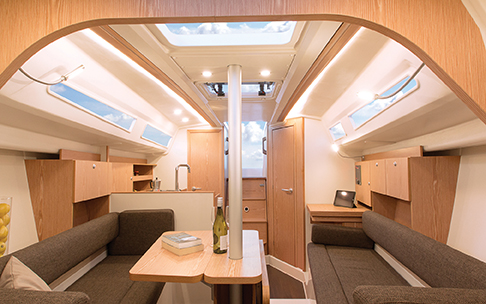 The companionway steps are well angled whether you’re coming up or down. This is a surprising luxury on a small boat where ladders are more the norm. Moving about and popping below is easier especially when heeling. One sacrifice is in the head that has no separate shower stall. It is still roomy with a sink, a Jabsco manual toilet, some storage and adequate room to change clothes. The standard interior finish on this model is a satin mahogany with upgrades to either light Italian oak or warm American cherry and fabric finishes allow every owner to personalize the décor.
The companionway steps are well angled whether you’re coming up or down. This is a surprising luxury on a small boat where ladders are more the norm. Moving about and popping below is easier especially when heeling. One sacrifice is in the head that has no separate shower stall. It is still roomy with a sink, a Jabsco manual toilet, some storage and adequate room to change clothes. The standard interior finish on this model is a satin mahogany with upgrades to either light Italian oak or warm American cherry and fabric finishes allow every owner to personalize the décor.
BWS THOUGHTS
The sail away package price for the Hanse 315 is $125,000, which includes most of what you’ll need above and beyond the $98,000 base. That’s a lot of boat for not a lot of money.
Ships have been built in Greifswald since the 1300s and the Hanse factory here has employed local craftsmen for the past 20 years. With that kind of history, that Hanse builds good boats is not surprising. That you can fit more than two 315s end-to-end in a 675 and that both models will work well for their intended purpose—now that’s a feat.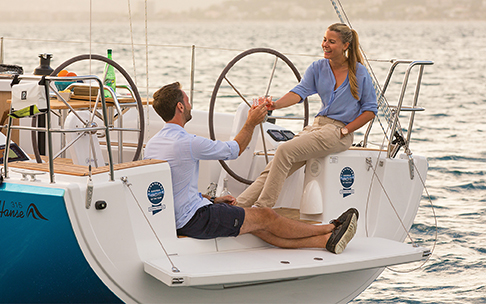
HANSE 315
Designer Judel/Vrolijk
& Co.
LOA 31’ 6”
LWL 28’ 5”
Beam 11’ 0”
Draft (shoal/deep) 6’ 1” or
shoal at 4’ 5”
Sail Area (100%) 506 sq. ft.
Displacement 10,361 lbs.
Water 60 gallons
Fuel 26 gallons

